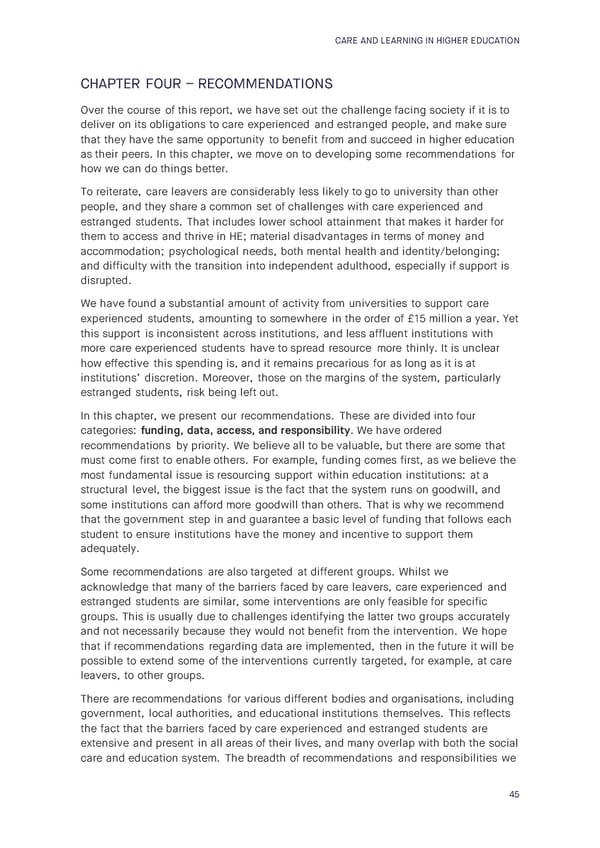CARE AND LEARNING IN HIGHER EDUCATION CHAPTER FOUR – RECOMMENDATIONS Over the course of this report, we have set out the challenge facing society if it is to deliver on its obligations to care experienced and estranged people, and make sure that they have the same opportunity to benefit from and succeed in higher education as their peers. In this chapter, we move on to developing some recommendations for how we can do things better. To reiterate, care leavers are considerably less likely to go to university than other people, and they share a common set of challenges with care experienced and estranged students. That includes lower school attainment that makes it harder for them to access and thrive in HE; material disadvantages in terms of money and accommodation; psychological needs, both mental health and identity/belonging; and difficulty with the transition into independent adulthood, especially if support is disrupted. We have found a substantial amount of activity from universities to support care experienced students, amounting to somewhere in the order of £15 million a year. Yet this support is inconsistent across institutions, and less affluent institutions with more care experienced students have to spread resource more thinly. It is unclear how effective this spending is, and it remains precarious for as long as it is at institutions’ discretion. Moreover, those on the margins of the system, particularly estranged students, risk being left out. In this chapter, we present our recommendations. These are divided into four categories: funding, data, access, and responsibility. We have ordered recommendations by priority. We believe all to be valuable, but there are some that must come first to enable others. For example, funding comes first, as we believe the most fundamental issue is resourcing support within education institutions: at a structural level, the biggest issue is the fact that the system runs on goodwill, and some institutions can afford more goodwill than others. That is why we recommend that the government step in and guarantee a basic level of funding that follows each student to ensure institutions have the money and incentive to support them adequately. Some recommendations are also targeted at different groups. Whilst we acknowledge that many of the barriers faced by care leavers, care experienced and estranged students are similar, some interventions are only feasible for specific groups. This is usually due to challenges identifying the latter two groups accurately and not necessarily because they would not benefit from the intervention. We hope that if recommendations regarding data are implemented, then in the future it will be possible to extend some of the interventions currently targeted, for example, at care leavers, to other groups. There are recommendations for various different bodies and organisations, including government, local authorities, and educational institutions themselves. This reflects the fact that the barriers faced by care experienced and estranged students are extensive and present in all areas of their lives, and many overlap with both the social care and education system. The breadth of recommendations and responsibilities we 45
 Care and Learning in Higher Education Page 45 Page 47
Care and Learning in Higher Education Page 45 Page 47